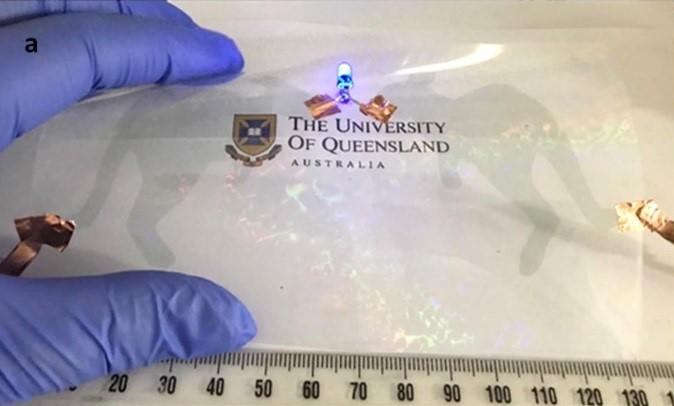Jun 11 2020
Scientists from Australia have proven the high potential for using a new type of flexible, recyclable electrodes to make inexpensive touchscreens, solar cells, next-generation responsive windows, and wearable “e-skins.”
 TiO2/Au/TiO2 nanomesh on PET substrate as a kangaroo-patterned transparent and flexible circuit to light up a blue LED. Image Credit: Dr. Tengfei Qiu.
TiO2/Au/TiO2 nanomesh on PET substrate as a kangaroo-patterned transparent and flexible circuit to light up a blue LED. Image Credit: Dr. Tengfei Qiu.
Such materials are produced through an easy, economical fabrication process and could serve as alternatives to conventional transparent conductive oxides like indium tin oxide (ITO). ITO is an essential component of virtually all smartphone displays, laptop screens, and thin-film solar cells, but its cost has been surging steadily because of its scarcity and it is restricted inherently by its fragile nature.
Besides cost-effective, high-efficiency photovoltaic solar cells, smartphone touch screens, and computer displays, household energy bills could be reduced in the longer term, and the electrodes can be utilized to produce smart windows, which can electrically change color and turn transparent or opaque.
The performance of the material is excellent, the transmission of above 90% and high electrical conductivity rivals the ITO benchmark.”
Dr Eser Akinoglu, Study Contributing Author, ARC Centre of Excellence in Exciton Science
Looking forward to the research’s potential commercial application, Akinoglu added, “In principle, you should be able to integrate this technology into industrial roll-to-roll printing.”
A deposition technique known as nanosphere lithography was used to achieve these electrodes. In this technique, the preferred combination of materials is evaporated into a nanoscale pattern. Scientists from the University of Queensland and ARC Centre of Excellence in Exciton Science have reported the study results in the Advanced Functional Materials journal.
The dielectric/metal/dielectric (D/M/D) nanomesh electrodes created using this method exhibited accurately controlled wire width, perforation size, and uniform hole distribution, which yielded excellent flexural endurance, high transmittance, and low sheet resistance (which reduces the loss of voltage).
We offered a strategy to make the shadow area of the metallic nanomesh highly transparent, by integrating D/M/D structures to the nanomesh system. The nanomesh transparent films with D/M/D layered structure have not been studied before. The simple and cost-effective nanosphere lithography technique can be applied to fabricate diverse layered nanomesh materials.”
Dr Tengfei Qiu, Study Lead Author, University of Queensland
Furthermore, in some flexible electrochromic applications, the electrodes even exhibited the ability to be recycled, thereby improving the credentials of the mechanism as a viable, sustainable alternative to standard manufacturing materials and processes.
Discussing this recyclable characteristic, Dr Akinoglu stated, “It means that if you make a device like an electrochromic window, which may deteriorate in functionality after its life-span, you can take it apart, flush rinse the electrodes, and reuse them for another device.”
For the researchers, the next step forward would be to investigate the potential demonstrated in this study to achieve similar outcomes at a larger scale, with a long-term goal of obtaining the same results in a commercially feasible capacity.
You want to get the transparency higher, you want to get sheet resistance lower and you want to get the endurance for mechanical stress and flexibility higher. And you want to be able to fabricate it on a large-scale area, at a low cost.”
Dr Eser Akinoglu, Study Contributing Author, ARC Centre of Excellence in Exciton Science
According to Professor Lianzhou Wang, senior author of the study, “This work will inspire the design of transparent conductive films with novel functions such as flexibility and recyclability, providing an excellent platform for next generation eco-friendly optoelectronics.”
Journal Reference:
Qiu, T., et al. (2020) Trilayer Nanomesh Films with Tunable Wettability as Highly Transparent, Flexible, and Recyclable Electrodes. Advanced Functional Materials. doi.org/10.1002/adfm.202002556.